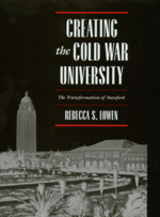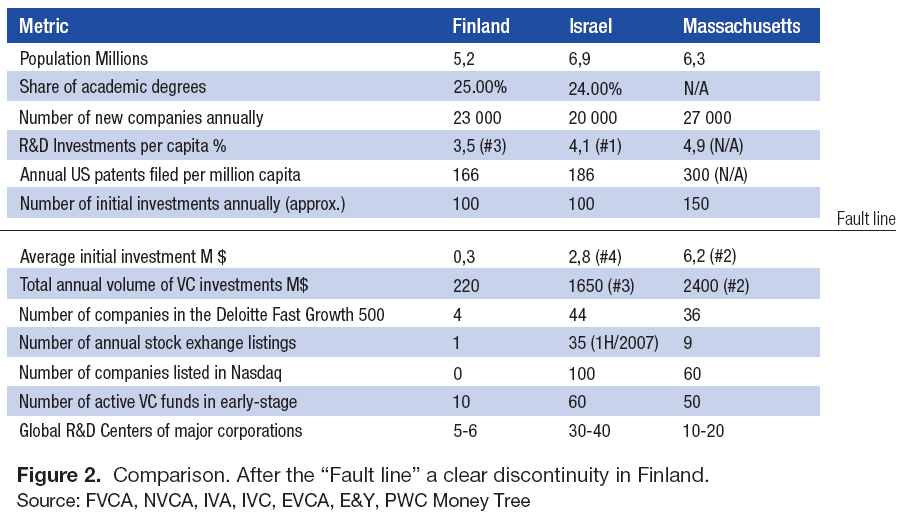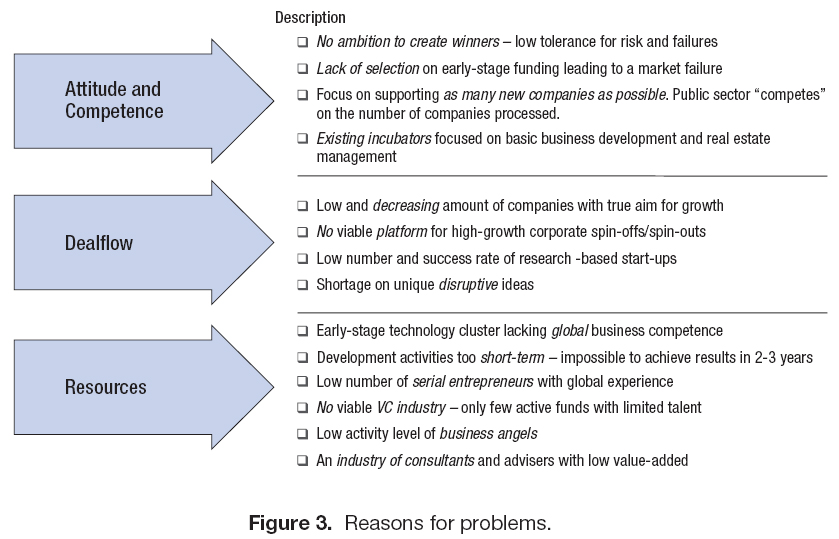Je viens de lire un excellent rapport sur l’innovation et les régions françaises. L’innovation, inutile de le rappeler trop, est un sujet complexe. La profondeur de l’analyse des auteurs, Thierry Madiès et Jean-Claude Prager, de Innovation et compétitivité des régions est remarquable. Pourtant le sujet est loin d’être facile à analyser, mais l’impression qu’il laisse est forte. On y trouvera toujours à redire, je ferai quelques remarques plus loin mais je le trouve vraiment très bien fait.
Du côté de la synthèse en profondeur, j’ai beaucoup aimé leur panorama sur les théories fondatrices des politiques régionales :
1. Base d’exportation
Cette approche, une des plus anciennes des théories de la croissance régionale, est une transposition territoriale des modèles de croissance post-keynésiens. Les activités d’exportation sont l’élément principal de la dynamique économique régionale alors que la croissance des branches productrices des biens et services pour le marché local dépend de la croissance du secteur d’exportation. Le développement de la région est conditionné par la demande externe dont l’effet multiplicateur est lié à la propension marginale à consommer localement ; la compétitivité de la région dépend principalement de l’accumulation des ressources et l’investissement dans les secteurs de la base, en fonction de leurs résultats et de mesures politiques incitatives à la localisation d’entreprises de ces secteurs.
2. Croissance endogène
La théorie de la croissance endogène spatiale est le paradigme dominant de la croissance régionale et des agglomérations urbaines. Le modèle « Marshall- Arrow-Romer » met l’accent sur le rôle primordial dans le progrès technique de l’accumulation des ressources humaines et leur niveau de qualification, l’importance de la R&D, en ajoutant la dimension territoriale des externalités et des rendements croissants (Glaeser et alii, 1992 et Audrestsch, 1998). Le rôle des politiques publiques est donc de développer le niveau de formation de la population, de renforcer les interactions entre les entreprises et les producteurs de connaissances, et de jouer sur la concentration des activités.
3. Théorie néo-schumpétérienne
L’accent est mis sur l’innovation comme moteur de la croissance dans un monde où la concurrence entre les entreprises se fait principalement par l’innovation (Baumol, 2002). Le « milieu innovant » est décisif pour la réduction des risques et le développement des réseaux de connaissance (Camagni, 1991 et Aydalot, 1985) car l’entrepreneur dépend de son milieu, qui lui offre un cadre favorable ou non à son succès. Les agglomérations urbaines développées sont plus propices que les autres régions car elles contiennent des ressources et un réseau dense d’infrastructures variées qui permettent de mieux faire face aux nombreuses incertitudes de l’entreprise en création ou en développement (Scott, 2004). Les recommandations politiques portent sur l’utilité d’un agent coordonnateur pour l’animation du milieu et encourager l’esprit d’entreprise tout en favorisant la concurrence, considérée comme le moteur principal de l’innovation.
4. « Théorie » des clusters
L’approche clusters (Porter, 1990) est devenue un élément incontournable des doctrines de développement régional, d’autant plus populaire que sa définition est incertaine et sa base, aussi bien théorique qu’empirique, fragile (Enright, 2002, Martin et Sunley, 2002 et Maskell et Kebir, 2005). C’est une reprise de l’analyse de la base économique fondée non pas sur les secteurs d’activité mais sur les grappes d’entreprises appartenant à la même chaîne de valeur. L’environnement microéconomique des clusters détermine leur compétitivité. Le « diamant » de Porter comprend quatre dimensions principales : les inputs de l’innovation, le contexte local de la concurrence, la nature de la demande locale, et l’intensité des réseaux entre les entreprises du cluster. C’est le
5. Théorie institutionnaliste
Dans la mesure où l’activité économique est considérée comme d’abord « enchâssée » dans la vie sociale, le capital social d’une région, c’est-à-dire l’ensemble des comportements, formes et institutions publiques et privées (Putnam, 1993), représente un élément central de l’environnement des entreprises et de leur compétitivité (Amin, 1999 et Casey, 2004). Les études empiriques sur le lien entre le capital social et la croissance économique ne sont cependant pas concluantes, notamment pour distinguer un effet régional spécifique différent des données nationales (Casey, 2004 et Beugelsdijk et van Schaik, 2005). L’évolution de la région est conditionnée par un phénomène de « path dependency ». Les politiques de développement doivent s’adresser à la base institutionnelle sous ses formes les plus diverses (associations d’entreprises, organisations politiques locales…) pour contribuer à la richesse des réseaux sociaux et à leur flexibilité ; l’implication de ces réseaux dans la gouvernance collective est une dimension majeure de cette capacité institutionnelle et de l’inclusion sociale qui permettent la mobilisation la plus large des ressources de la région et devient ainsi, en tant que telle, un objectif central des politiques économiques.
6. Théorie évolutionniste
La doctrine évolutionniste considère que la compétitivité des régions dépend de leur capacité à renouveler leur base économique face au processus de destruction créatrice (Boschma, 2004). Les facteurs précis de la meilleure capacité d’adaptation de certaines régions à de nouveaux paradigmes technicoéconomiques restent cependant un sujet de débats ; les régions tendent à développer des institutions et des comportements collectifs routiniers, à se spécialiser dans des secteurs d’activité qui les enferment dans des rigidités et risquent de verrouiller le système d’innovation. Le rôle des politiques publiques est plus large que celui de la simple correction des défaillances de marché ; il est de guider les agents économiques pour faire face à des changements dans la structure du marché, grâce au pouvoir de l’État de peser sur la coordination des anticipations des agents face aux changements structurels, même si sa capacité d’agir directement sur l’évolution des systèmes économiques est réduite et si son information n’est pas supérieure à celle des agents privés (Moreau, 2004). Les politiques doivent renforcer en permanence la capacité d’adaptation, réduire les rigidités des systèmes régionaux d’innovation, encourager la formation permanente de nouveaux réseaux de connaissance ouverts sur l’extérieur, tout en s’appuyant sur leurs forces les plus marquées tout en facilitant les secteurs émergents qui correspondent le mieux à leurs potentialités. Il s’agit donc d’accepter un certain degré d’incertitude dans des choix stratégiques qui passent par la caractérisation de signaux faibles.
7. Théorie culturelle
Le rôle de la dimension culturelle dans le développement des régions a été bien mis en lumière dans l’analyse comparée du développement de
Est-il nécessaire de dire à quel point je suis sensible à cette septième théorie, mais aussi à leur citation de Schumpeter « L’innovation passe par les entrepreneurs ».
Et que dire de leur analyse de
Les facteurs de succès du modèle de régulation par le marché de
Les facteurs de succès sont les suivants :
• un environnement favorable à l’entrepreneuriat ;
• un niveau exceptionnel de chercheurs (150 000 dans la région) ;
• une main d’œuvre de haut niveau et fortement flexible ;
• un attracteur des talents à l’échelle mondiale ;
• une méritocratie tournée vers les résultats ;
• une culture du risque et de l’échec ;
• des universités orientées vers l’industrie ;
• une qualité de vie exceptionnelle ;
• des réseaux de contacts nombreux et nourris ;
• une forte infrastructure de services et d’organismes financiers. Mais également des crédits de recherche publics de 3 % du PIB régional, à la fois raison et conséquence de ce dynamisme unique au monde.
La belle synthèse qu’un des auteurs fait dans un autre rapport qui décrit la Silicon Valley est passionnante (et brève !). Les auteurs sont très nuancés sur les indicateurs de l’innovation, ils montrent bien aussi la difficulté à imiter cette Silicon Valley tant elle semble ne pas avoir été planifiée.
Si j’ai une réserve à faire c’est de n’avoir pas trouvé assez les mots de passion et folie. Mais nous sommes là dans le quantitatif. Mon récent post sur le livre de Lee Smolin n’est pas étranger à
Ce rapport me rappelle aussi Victa que j’avais il y a quelque temps brièvement décrit. Nous faisons de gros efforts pour innover, mais au bon endroit ? Je crois que le capital humain est critique comme l’indique les auteurs. Mais comment le développer est loin d’être simple tant la prise de risque, l’acceptation de l’incertitude et la tolérance de l’échec sont nécessaires. Or il faut aussi contrôler, surtout l’argent public. Or un échec peut être plus riche d’enseignements qu’un succès… Quand les auteurs par exemple proposent de « concentrer sur les grandes priorités », je ne suis pas sur que l’internet pouvait être vu comme une grande priorité entre 1990 et 1993-94. Incertitude à nouveau.
PS : mon post en anglais fait allusion à un autre rapport, What is the right strategy for more innovation in Europe?, lui aussi très intéressant…









